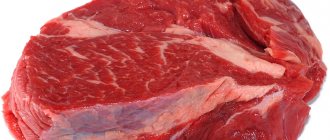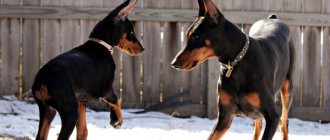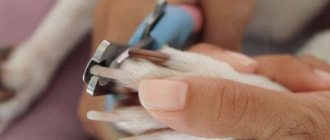Indications
Castration of females and males is recommended in the following cases:
- In order to improve the working qualities of dogs. If a male dog is used for hunting, protection, as a guide or sled dog, removal of the gonads will allow the dog not to react to individuals of the opposite sex and completely concentrate on work.
- To prevent uncontrolled reproduction. When keeping a sexually mature bitch, there is a possibility of uncontrolled conception. Removing the gonads will eliminate the need to house the puppies.
- If there are medical indications. Among medical diagnoses that require removal of the gonads in male dogs, cryptorchidism is the most common. Cryptorchid must be castrated due to the high likelihood of developing an egg tumor. For male dogs, surgery is also performed for prostatitis, cystic or other neoplasms in the gonads. Castration of a female dog may be necessary if there are serious complications during pregnancy.
- Correction of dog behavior. Removal of the testes is recommended for male dogs with spontaneous ejaculation, frequent groundless erections, and attacks of unmotivated aggression. This dog behavior can be caused by an excess of sex hormones. Usually, after castration, the dog becomes calmer and more manageable, aggression and the need to prove its leadership disappear, and the male stops marking his territory.
Experts recommend spaying all female dogs not intended for breeding. Males should undergo selective castration, guided by lifestyle and behavior (whether he marks his territory, how he reacts to other dogs and people).
Castration of a dog: advantages of this operation
Why do dog owners perform such an operation and why can’t they resort to a simpler version of stopping reproductive function - sterilization.
Neutering for dogs may be recommended in the following cases:
- A pathological disease in males is cryptorchidism (non-descent of one or two testes into the scrotum).
This disease can have serious consequences, such as cancer, therefore, it is recommended to have an operation to castrate the animal to avoid complications.
Contraindications
Before the intervention, the dog is examined and all possible contraindications are excluded. Based on the results of the examination, the veterinarian decides whether the dog can be operated on.
It is not recommended to perform surgery on animals with diseases of the cardiovascular system and kidneys. Intervention at too early (in a puppy before 4-5 months) or mature (in a dog after 5-6 years) age is also associated with health risks.
It is worth postponing the operation in cases where the dog is weakened and exhausted, its appetite is impaired, and there is a deterioration in the condition of the coat. Castration of males and females is not carried out within 30 days after vaccination.
Castration of a dog: pros and cons
Undoubtedly, the indications for castration make it possible to single out this method as particularly favorable for the general condition of the animal, but in addition to the advantages, there are also disadvantages. Let's look at the pros and cons of castration in more detail.
Pros:
— the inability to reproduce significantly reduces the risk of an unwanted pregnancy for the bitch, and, as a result, does not cause problems for the owners related to the future placement of offspring;
— the dog’s behavior (especially males) can be corrected. Castrated dogs behave more calmly and are considered more domesticated;
— the risk of developing cancer is reduced, and, as a result, it becomes possible to increase the pet’s life expectancy.
Minuses:
— the reaction of anesthesia to the dog’s body;
- possible diseases of the urinary system (rare);
- increasing the likelihood of developing obesity and vascular problems.
With proper treatment and maintenance of your pet's health, these disadvantages can be avoided.
Points for and against
Neutering a dog will help make a male or female dog more suitable for home keeping. However, the operation can cause some pathologies. Before deciding to castrate a dog or bitch, you should carefully weigh the pros and cons. A visit to the veterinarian and a preliminary examination will help to assess the possible risks for the dog. Information about the procedure can be found on the Internet: every dog breeding forum has topics dedicated to the issues of castration of males and females.
Many owners begin to think about castrating their puppy after puberty. Often during this period, the dog’s behavior changes noticeably: the male marks his territory and shows interest in the females, the females run away from home. An increase in the amount of sex hormones also affects the character: the animal becomes uncontrollable and has causeless outbursts of aggression. Does castration of dogs help in such cases? If the changes are caused by hormonal imbalances, castration helps eliminate marks in the house and makes it possible to correct the dog’s character. However, you should not count on a positive result if the pet’s behavior is a consequence of bad manners and lack of training, or if the dog initially has a cocky disposition.
The question of whether castration is necessary for a male dog that does not show pronounced changes in character and lifestyle does not have a clear answer. Today, a number of experts believe that the procedure should be selective: intervention should be performed on male dogs that are unable to cope with the influx of hormones or are prone to certain diseases.
pros
What does castration of dogs give:
- Bitches and males lose their ability to reproduce, which helps prevent the birth of unplanned puppies.
- The dog becomes calmer and more balanced.
- The dog's life expectancy increases, the risk of developing prostatic hyperplasia and prostatitis in males, diabetes mellitus, and malignant neoplasms is reduced.
Minuses
Regardless of what types of castration are used, they all lead to changes in hormonal balance and do not always have a positive effect on the dog’s condition. Negative consequences may be as follows:
- In young dogs, the risk of pathologies such as hypothyroidism, bone cancer, and vascular tumors increases;
- There are disturbances in the functioning of the urinary system (a significant percentage of bitches develop urinary incontinence);
- An adult male dog may experience behavioral abnormalities, sleep disturbances, and disorientation.
Features of cryptorchid castration
Dogs with pathologies of the location of the testicles suffer from the following ailments:
- the formation of tumors that degenerate into malignant ones;
- inguinal hernia;
- pathologies of the penis and preputial sac;
- prostatitis;
- diabetes.
Animals are aggressive and sexually active. It is necessary to prevent mating, because deformity is inherited.
An undescended testicle may be located in the male dog’s groin or abdominal cavity. In the first case, the surgical technique differs slightly from conventional castration. For subcutaneous localization, the scrotum is cut, the testis is squeezed out, the cord is ligated, and it is cut off. When the testicle is located in the abdominal chamber, abdominal surgery is indispensable.
Removed testicles
Some owners wish to maintain the full appearance of a male. They ask a veterinarian to insert a prosthesis into the dog. Unscrupulous dog handlers hope to receive a positive assessment at the exhibition. After all, a cryptorchid, which has one testicle preserved, is capable of fertilization. Experienced experts have learned to distinguish dummies from real testicles and expose scammers.
Age
The optimal age for intervention is immediately after puberty. The timing may differ for large and small dogs: in small breeds, puberty usually occurs at 5-7 months, in large breeds at 8-10 months. A veterinarian will help you determine more accurately at what age it is best to have surgery on your dog.
Castration of a puppy too early can lead to disorders of the genitourinary system and developmental abnormalities. When a male dog is castrated in adulthood, there is a high probability of maintaining sexual behavior. Surgeries are performed for medical reasons regardless of the dog’s age.
Castration (orchidectomy) of a male dog
- a medical examination is performed, with special attention to the heart rate and general condition of the body;
- preliminary injection to easily calm the animal;
- general anesthetic;
- preparation of the surgical site (plucking, sterilization with antiseptic);
- incision along the midline of the scrotum;
- the testicle is pushed out through the incision
the tissue is separated from the testicle, exposing the vasculature that provides blood supply to the testicle, as well as passages for sperm (Fig.);
the vascular tissue connecting the testicles to the body is clamped, ligated and moved into the body Fig.
Methods
Surgical or chemical castration can be used on dogs.
Chemical
This method is reversible. Under the influence of the drug, the production of sex hormones stops, resulting in infertility in the dog after 3-4 weeks. This method is recommended for dogs with intolerance to anesthetics, as well as male dogs of hunting, service and guard breeds to improve working qualities.
Surgical
Surgical methods involve removing the testes or ovaries from dogs through incisions in the scrotum or abdominal cavity. As a rule, the intervention takes place under general anesthesia and requires certain preparation and rehabilitation.
Recently, laparoscopy has been increasingly used. Castration of a dog is carried out using a special instrument, which is inserted through small punctures. This technique minimizes possible complications both during and after the procedure, and the dog’s rehabilitation is much faster.
Types of male castration
Medicinal (chemical)
This temporary castration is used as an alternative to surgical castration. This method is based on the introduction of a special implant with medicine under the skin. Slowly released and entering the blood, the active substances cause a reversible castration effect in males, lasting up to 2-3 years. In this case, you will not have to expose the animal to anesthetic risks.
Orchidectomy
Testicular removal surgery involves general anesthesia and an incision in the midline of the scrotum so that each testicle can be excised or completely removed. External stitches are usually not required.
In the case of a phenomenon that is often present in males (male dogs) where both testicles descend before birth from the abdominal cavity through the inguinal canal into the scrotum (cryptorchia), a complex operation with deep excision and suturing will be required.
Postoperative period
Care in the first hours consists of monitoring pulse, respiration, and temperature. The duration of the most difficult period depends on how long the dog recovers from anesthesia. After gas anesthesia, the animal comes to its senses quite quickly; with intravenous administration of drugs, coordination of movements is restored within several hours. If, before fully recovering from anesthesia, the dog began to pee under itself, this is not considered a deviation. A cause for concern should be that the pet does not go to the toilet for too long, or urination problems are observed after 12-24 hours.
After 3-4 hours, you can offer the dog water and a small amount of food. Some males and females may experience a lack of appetite for 1-2 days.
In the first days after castration, surgical sutures and incisions on the scrotum in male dogs require special attention. If your dog is licking wounds, it is recommended to use a collar. The veterinarian will tell you how long to wear the collar.
If you properly care for your dog in accordance with the advice of a specialist, your pet’s recovery will be as quick as possible.
Preparing a dog for castration
Before the operation, the veterinarian will initially take tests from the animal, therefore, on the day of treatment, no one will be able to perform castration.
If you have planned castration of your dog in advance, we recommend that you carry out the following preparatory procedures:
- In 1-2 months
Treat the animal against parasites using shampoo, drops and other means. It is also recommended to deworm the animal.
By this period, all scheduled vaccinations must be completed.
- For three days
Switch your dog to light food and proper nutrition. Eliminate unhealthy foods, sweets, bones, flour, etc.
- Per day
12 hours before the planned surgery, the dog is not fed, only water. Even water is excluded 6 hours before surgery.
Prepare your dog's bed: renew it, wet clean it nearby. Prepare transport and things for transporting the dog. Take napkins, disposable diapers and antiseptic with you.
It is also recommended to purchase a collar after your dog is neutered.
Support your pet and be close to him, making it clear that nothing bad will happen.
Complications
Removal of the gonads in dogs usually occurs without serious complications. After castration of male dogs, swelling of the scrotum may be observed, which goes away on its own within 1-2 days. The most common complications in dogs include wound infection, abscesses, and suture dehiscence.
If post-operative swelling does not go away within a few days, pus or blood is released from the wound, the dog has no appetite and has a fever, you should seek veterinary help.
Recovery after castration of dogs
When the dog regains consciousness after anesthesia, it can be taken home. Surround your pet with care and attention during the recovery period.
The seam after castration of the dog must be treated with special solutions. If you notice that the seam looks unnatural or notices a discrepancy, consult a doctor as soon as possible.
After the operation, the dog must be kept in a warm place without drafts, since all efforts will be directed to restoring the body, which is why the immune system is weakened.
In the first hours after surgery, the dog needs to be given a little water, after 4 hours you can offer food.
Watch how the dog reacts to the seam: if it chews or scratches it, put a collar on it.
A week after castration, it is recommended to take the dog for examination. If the suture was sewn with non-absorbable threads, then after 10 days it will be necessary to remove the sutures.
After this, the most difficult period will be over, and the dog’s recovery will be significantly accelerated.
Don’t rush to introduce your dog to normal mode; its body is not yet ready for active games and training.
Location
Castration of dogs can be carried out both in a veterinary clinic and at home. The main condition for a successful outcome of the procedure is contacting a qualified veterinarian. You should not risk the health and life of your dog by turning to dubious specialists who offer inexpensive castration, or by trying to castrate a male dog yourself, guided by articles, videos and photos from the Internet.
At home
The location of the operation should be chosen taking into account the age, condition and gender of the dog. You can castrate young male dogs at home without identified chronic diseases. The cost of the procedure in this case will be slightly higher than in a veterinary clinic.
Vet clinic
Due to the high probability of complications, castration of an old dog is best done in a specialized institution. The veterinary clinic is the optimal choice for castrating sick animals for medical reasons, male dogs with cryptorchidism, as well as performing abdominal surgeries on female dogs. The presence of specialized equipment minimizes the negative consequences of various critical situations.
Castration of a dog is a serious intervention, successful recovery from which depends on the qualifications of the specialist. Before entrusting your pet to a veterinarian, you should inquire whether he has sufficient experience in carrying out such operations and read reviews from dog owners.
Castration of cats
Castration of stallions
Castration of sheep
Reasons for castration of male dogs
- control over the population of the species (prevents bitches from becoming pregnant);
- may prevent urinary problems due to prostate enlargement;
- reduces the risk of testicular cancer;
- reduces the risk of prostate tumors;
- reduces the occurrence of perianal hernias and tumors;
- reduces hormone-related aggression (territorial master);
- reduces “urine spraying” territory marking in indoor dogs;
- reduces the chance of getting injuries and abscesses, as well as becoming infected with viruses and transmitting them to other dogs;
- the absence of a hormonal call to search for the opposite sex limits movement around the territory and the likelihood of going missing or getting hit by a car;
Call a veterinarian Moscow
+7(495)162-70-70
Postoperative care for animals
Males need less care after surgery than females. Due to the physiological location of the genital organs, castration of a male is much easier.
General requirements for the care of post-operative dogs:
- The animal is discharged from the veterinary clinic even before waking up. Due to the fact that anesthesia affects heat exchange, the dog may freeze. She should be covered with a warm blanket.
- Upon arrival home, your pet needs to be given a quiet, calm place where no one will disturb him. You will need a moisture-absorbing diaper, as the dog can urinate on itself.
- Do not feed for at least 4 hours after surgery. Since vomiting is possible after anesthesia. Next, you should provide a gentle diet for 2-3 days. For natural-fed pets, these are liquid porridges. Dry food must first be soaked in water.
- For any systematic ailments (vomiting, diarrhea, decreased or increased body temperature), contact the clinic.
It is important to monitor your pet's condition during drug-induced sleep. If convulsions begin, the pulse rate or temperature rises sharply, this is a reason to return to the veterinary clinic. It is also necessary to monitor the time that has passed since the operation. The dog should wake up no later than 6 hours later.
Among other things, it is necessary to carefully ensure that the pet does not lick the stitches; for this, special blankets or medical collars are used.
Possible complications and contraindications
Contraindications to castration:
- Elderly animals.
- Puppies that are too young and have not been immunized against viral diseases.
- Obese dogs.
- Individuals with weakened immunity after illness.
- Pets with high breeding value for the breed (as a recommendation).
- Other diseases for which anesthesia is contraindicated.
There may be several options for complications after castration:
- The operation was performed incorrectly; the internal organs were not completely removed. In this case, a repeat operation is required.
- Abscesses and purulent inflammations can occur when an infection is caused by an unsterile instrument or the suture is not properly treated.
- Suture dehiscence requires re-suturing if the edges of the wound have not yet closed. Large, heavy dogs are most susceptible.
- Disturbances in the functioning of the heart and lungs after anesthesia or an allergic reaction to the drug.
In case of inflammatory processes caused by infections in the wound, it is imperative to take a course of broad-spectrum antibiotics. The seam will require more attention; treatments should be more thorough and frequent.
Very often, postoperative complications arise due to the fault of the animal owner . In this case, the expression “heals like a dog” has no practical meaning. The animal must be restricted in movement until the seam is completely closed.
The scar itself needs care and daily treatment . It is necessary to maintain cleanliness and ensure that no dirt gets into the cut. To do this, before going for a walk, you need to put protective clothing on the dog or secure the seam in any other way.
The owner of a dog is most often frightened by its reaction to anesthesia . Severe shaking, vomiting, disorientation. They should disappear within the first day after surgery. Animals often have an allergic reaction to drugs used for anesthesia. It is impossible to predict the pathological consequences. They depend on the individual characteristics of the pet’s body.
Advantages and disadvantages of the procedure
The benefits of castration include:
- No unwanted puppies;
- Prevention of a number of diseases (including cancer);
- Lack of uncontrollable hormonal surges;
- Calmer, flexible behavior;
- Decreased sexual desire;
- Protection against inflammatory processes and sexually transmitted infections;
- The dog becomes more owner-oriented;
- There is no tendency to escape;
- According to statistics, castrated animals live longer.
Destructive behavior associated with sexual desire is easier to correct in castrated animals. Sometimes, in the absence of major sex hormones, inappropriate behavior goes away without correction.
The main disadvantage of castration is the need for anesthesia . Dogs have a much harder time recovering from anesthesia than humans. And before performing an operation, a veterinarian’s consultation is necessary for each individual case. For some animals (especially older and obese animals), the castration procedure may be contraindicated.
It is believed that castrated animals are more susceptible to bone cancer and hypothyroidism due to an imbalance of thyroid hormones. This information has no scientific basis; both castrated and natural dogs suffer from cancer or hypothyroidism.
What types of anesthesia are used
The most popular types of anesthesia today are:
- General anesthesia - the dog is in a state of deep sleep, only the brain and heart function. The animal does not hear or feel anything and wakes up at the end of the operation. The most dangerous type of anesthesia, the slightest overdose can lead to cardiac arrest, while an insufficient dose can lead to the dog waking up even during the doctor’s manipulations.
- Local anesthesia - the animal is conscious and can move, but does not feel pain, if we transfer the analogy to a person - local anesthesia is similar to dental freezing. Used in dogs with medical contraindications to general anesthesia.
- Epidural anesthesia - the dog is conscious, but does not feel anything and cannot move, the most gentle method of anesthesia for animals with a weak cardiovascular system. The injection is made into the spine - between the last sacral and first caudal vertebrae.
Sometimes general anesthesia is used in combination with local anesthesia to avoid pain after surgery.











